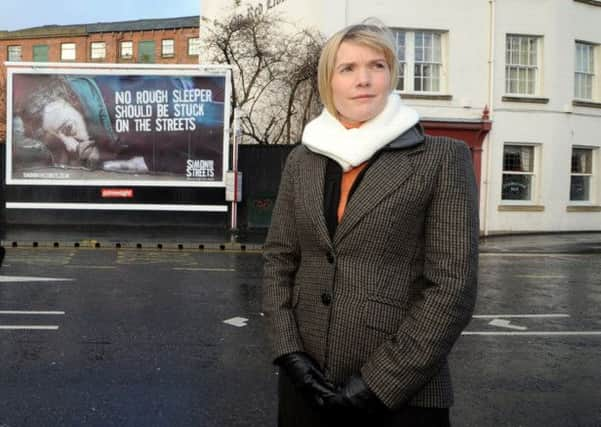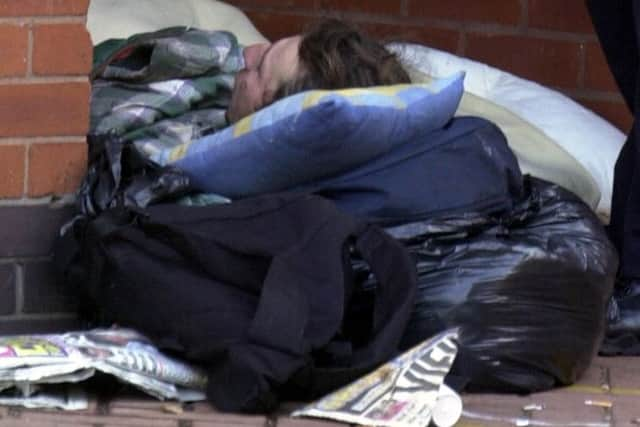Working to ensure those who live and die on a city’s streets are not forgotten


On Leeds Bridge a blue plaque marks the spot where Louis Le Prince shot the world’s first moving images. A second, on the towpath close to the Royal Armouries, commemorates the life of civil engineer John Smeaton.
In less frequented areas of the city, there’s another set of blue plaques. These ones are not at eye level. Instead they are a foot or so from the ground. One reads simply, “Trevor (1971-2010). Talented rugby player and homeless man. Lived in this doorway in 2008.”
Advertisement
Hide AdAdvertisement
Hide AdA short walk away there’s another. This time its to Frankie, a rough sleeper and amateur comedian. Between 2005 and 2009 he spent countless nights under Crown Point bridge. He died the following year.


The plaques were erected by Simon on the Streets with the support of the MRL design agency and marketing company Ponderosa, partly to afford a little dignity in death to those who received little of it in life and partly to prick the conscience of those walking past.
It did the job, but there is more to do. Since January, three of the rough sleepers the charity works with have died.
“People will say, ‘well, it has been very cold’, but you know what? Death among rough sleepers isn’t seasonal,” says Simon on the Streets general manager Helen Beachell. “We can quite as easily get a spike in August as we can in December. Part of the reason for the plaques was to humanise their stories. The man you see begging might have been the best runner in his school; the girl asleep in a doorway might love to dance.
Advertisement
Hide AdAdvertisement
Hide Ad“Everyone is someone’s child, they feel pain and joy like the rest of us, it’s just that life has dealt them a pretty poor hand.”
The three men who died recently were aged between 38 and 60 and all suffered complications relating to alcohol addiction. It’s typical of the people who Simon on the Streets work with and there will be more. The average age of death for male rough sleepers is 47. For women, it’s 43.
“Other agencies who are Government-funded work on payment by results,” says Helen. “I get that, if they can’t show they are succeeding why keep investing money? However, the net result is that they select people who they know they can help. The people we work with don’t tick that box, their problems can not be solved within a 12-week period. What we do is quite different from anyone else. We are there to help the people no-one else can.”
Simon on the Streets began in Leeds in 1999, but more recently expanded into Huddersfield and Bradford. However, wherever they go the formula is the same. By walking around city and town centres, along both main streets and forgotten corners, support workers identify rough sleepers. Then the hard work begins. Each worker is trained in communication and behavioural techniques like neuro-linguistic programming and as well as signposting rough sleepers to services they might need, they also act as their advocate.
Advertisement
Hide AdAdvertisement
Hide Ad“These are people who for often very good reasons have a complete distrust of authority,” admits Helen. “The first week our staff might just nod and say hello. The second week they might offer to buy them a sandwich and over the months a relationship builds. There are great organisations which exist to provide people with a hot meal or a bed for a night. What we provide is long-term emotional support.”
Each of Simon on the Streets’ case workers will deal with between 12 and 15 individuals at any one time and across West Yorkshire the charity has in excess of 100 people on its radar. “That doesn’t mean that they are all rough sleepers now, some of them might have done a pretty good job of turning their life around, but our support doesn’t have a time limit,” says Helen. “We are there for however long they want us to be.”
Working on the frontline of poverty inevitably has its frustrations, none more so than the regular counts of rough sleepers. Carried out by official bodies, they often record numbers in single figures and always seem to suggest the problem is in decline.
“It’s a waste of time,” says Helen. “The criteria is so strict in terms of what counts as a rough sleeper that sometimes I’m surprised they find anyone. They look for people in shop doorways, but they don’t look up fire escapes, they don’t look under flyovers just outside city centres.
Advertisement
Hide AdAdvertisement
Hide Ad“My other bugbear is when people say, ‘I don’t know why such and such is sleeping rough when they’ve got a perfectly good flat’. Yes, they might have a flat, but don’t imagine it’s anywhere anyone would want to spend any time because it isn’t. There was one of our guys whose front door would no longer close, who had to go downstairs to use the toilet because his own was cracked. His only company was an old mobile phone on which he used to play snake, and a wind-up radio. That’s not unusual in fact it’s pretty typical.”
On a more positive note, Helen says there has been something of a change in attitude in Leeds towards rough sleepers thanks largely to the city’s police force, but in many other towns and cities the policy remains one of disrupt and disperse.
“I get that councils want nice clean streets, but just moving rough sleepers on isn’t the answer. At least in the city centre there is a degree of safety, shove them out to the suburbs and they are much more vulnerable to attacks.”
Since its launch 15 years ago Simon on the Streets hasn’t received a penny of government funding. That has its advantages. It means they can be completely independent and when circumstances demand staff can stick their head above the parapet without fear of having their knuckles rapped or face threats of budget cuts. It also has a downside – each year they need to raise £300,000 to keep the charity up and running.
Advertisement
Hide AdAdvertisement
Hide Ad“The last few years have been tough,” says Helen. “A lot of other organisations which did receive money from the Government have seen their budgets shrink. That’s meant they have had to look to other sources like the charitable trusts we also rely on and our share of the pie has got smaller.
“Before the recession 60 per cent of our annual budget came from trusts, now it’s only 25 per cent. That’s as it should be, but it does mean we have had to become much sharper at fundraising.”
Over the next 12 months, Helen also knows that the demands on their services are only likely to increase.
“There will be a group of people who have just about hung on through the recession, but when the rest of society begins to feel wealthier some of them will fall off the cliff. When that happens, hopefully one of our support workers will be there to help pick up the pieces.
Advertisement
Hide AdAdvertisement
Hide Ad“I would love to say the day will come when there is no need for a charity like ours, but it won’t. There will always be vulnerable people and they will always deserve our help.”
What a donation can pay for
£5 will cover the cost of hot drinks that one worker buys for clients in one day. People will often take a few minutes to stop and sit down with the offer of a hot drink and that can be the start of a long term relationship with the charity.
£10 will pay for the mentoring of a volunteer on one street outreach session.
£25 will pay for 30 minutes of a soup run. Simon on the Streets had been doing a soup run for two hours every Tuesday for over 10 years as a way of getting access to those they aim to support.
For more information about the work of the charity as well as how to donate both time and money go to www.simononthestreets.co.uk